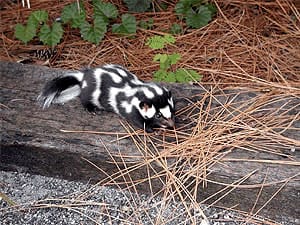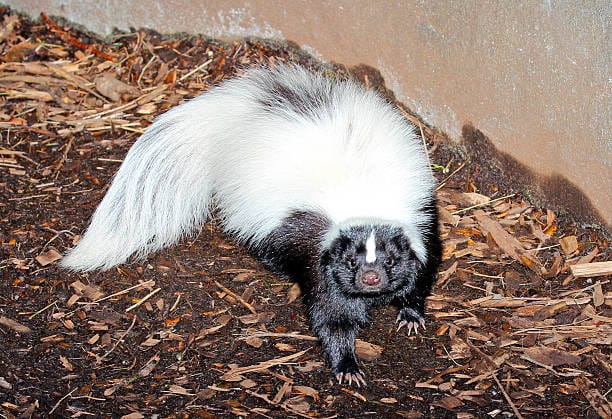Kentucky is home to several skunk species that play essential roles in controlling insects and small rodents. Although famous for their pungent defensive spray, skunks are fascinating nocturnal mammals with unique behaviors. This guide explores the types of skunks in Kentucky, including identification tips, behavior, habitat, diet, reproduction, and interactions with humans. Whether you’re exploring the Appalachian foothills, farmland, or suburban neighborhoods, this article will help you identify skunks safely and understand their ecological importance.
1. Striped Skunk (Mephitis mephitis)

Physical Characteristics & Identification Tips
The Striped Skunk is Kentucky’s most common skunk. It has a black coat with two bold white stripes running from its head to its bushy tail. Adults measure 20–30 inches long and weigh 6–10 pounds. Males are typically larger than females. Look for the distinctive V-shaped stripes and deliberate walking pattern, which serve as early warning signals before spraying.
Behavior
Nocturnal and solitary, Striped Skunks rest in dens or sheltered areas during the day and forage at night. They use hissing, foot-stomping, and tail-raising to warn before spraying. Despite their reputation, they are generally gentle and non-aggressive.
Habitat and Range
Widespread throughout Kentucky, Striped Skunks inhabit forests, fields, farmland, and suburban areas. They prefer areas near water and shelter, such as brush piles, rock crevices, and under porches.
Diet
Omnivorous and opportunistic, they eat insects, small mammals, eggs, fruits, and berries. Seasonal diet shifts occur, with insects dominating in summer and plant matter or rodents in winter.
Reproduction and Life Cycle
Breeding occurs February–March, with females giving birth to 4–6 kits in late spring. Kits are born blind and helpless but develop quickly. By fall, young skunks disperse to establish territories. Lifespan in the wild is 2–3 years.
Fun Facts / Noteworthy Traits
- Can spray up to six times before replenishing musk.
- Frequently groom themselves, maintaining cleanliness.
- Predators often avoid them due to strong scent.
Human Interaction
Most encounters are accidental. Secure trash, feed pets indoors, and block access under decks. Use hydrogen peroxide, baking soda, and dish soap to neutralize spray.
2. Eastern Spotted Skunk (Spilogale putorius)

Physical Characteristics & Identification Tips
Smaller than Striped Skunks, weighing 1–3 pounds and measuring 16–24 inches. Black coat with broken white stripes and spots. Slender build and fluffy tail. When threatened, it can perform a handstand with tail raised as a warning.
Behavior
Nocturnal and secretive, Eastern Spotted Skunks are excellent climbers and avoid human activity. Solitary, they inhabit barns, brush piles, and dense woodlands.
Habitat and Range
Found primarily in western and central Kentucky, preferring brushy areas, forest edges, and abandoned burrows.
Diet
Eat insects, small mammals, eggs, fruits, and occasionally reptiles, providing natural pest control.
Reproduction and Life Cycle
Mating occurs in late winter with delayed implantation. Kits are born in spring, usually 4–5 per litter. Lifespan is around three years in the wild.
Fun Facts / Noteworthy Traits
- Handstand warning display is theatrical and unique.
- Can climb trees and rocky terrain.
- Despite small size, spray is potent enough to deter predators.
Human Interaction
Rare in suburban areas. Preserve brushy edges and reduce pesticide use to support insects. Observe from a distance.
3. Hog-Nosed Skunk (Conepatus leuconotus) — Rare Visitor

Physical Characteristics & Identification Tips
Larger than other skunks, weighing up to 15 pounds. Pale dorsal stripe and pig-like snout adapted for digging. Rare in Kentucky, mostly seen in western counties.
Behavior
Nocturnal and solitary, they dig for insects, roots, and small animals. Spray when threatened after warning behaviors.
Habitat and Range
Native to southwestern U.S., occasional visitors may appear in open areas with loose soil suitable for digging.
Diet
Feed on insects, roots, small reptiles, and fruit. Digging aerates soil and helps control pests.
Reproduction and Life Cycle
Breeding occurs in early spring; litters of 2–6 kits. Kits stay in dens before joining foraging trips. Lifespan up to 4 years.
Fun Facts / Noteworthy Traits
- Snout is perfect for locating underground food.
- Wide dorsal stripe distinguishes it from other skunks.
- Rare visitors excite wildlife enthusiasts.
Human Interaction
Though rare, they help control pests. Observe safely and avoid disturbing them.
Conclusion
The types of skunks in Kentucky — Striped, Eastern Spotted, and rare Hog-Nosed — each contribute to pest control, soil health, and ecological balance. Understanding them allows safe coexistence while appreciating Kentucky’s nocturnal wildlife.
Frequently Asked Questions About Skunks in Kentucky
1. How many types of skunks are found in Kentucky?
Kentucky has three skunk species — Striped Skunk, Eastern Spotted Skunk, and the rare Hog-Nosed Skunk.
2. Which skunk is most common in Kentucky?
The Striped Skunk (Mephitis mephitis) is the most widespread and frequently seen species.
3. Where do skunks live in Kentucky?
They inhabit forests, fields, farmlands, and suburban areas, often near water or shelters like brush piles and decks.
4. Are skunks dangerous to humans or pets?
Skunks are not aggressive. They spray only when threatened, but can carry rabies, so avoid handling them.
5. What do skunks eat in Kentucky?
They are omnivorous, consuming insects, small mammals, eggs, fruits, berries, and occasionally reptiles.
6. When are skunks most active?
Skunks are nocturnal, primarily active at night, especially around dusk and dawn.
7. Do skunks hibernate in Kentucky?
No, they enter a semi-dormant state during cold spells but may forage on mild winter nights.
8. How can I tell a Striped Skunk from an Eastern Spotted Skunk?
Striped Skunks have continuous broad white stripes; Eastern Spotted Skunks have broken white patches and spots.
9. Are Eastern Spotted Skunks endangered in Kentucky?
They are a species of concern due to habitat loss and pesticide use, but not officially endangered.
10. How far can a skunk spray?
Skunks can spray up to 10 feet with accuracy and may repeat several times before depleting their musk.
11. What should I do if a skunk sprays near my house?
Ventilate the area and clean with a solution of hydrogen peroxide, baking soda, and dish soap.
12. Can skunks climb trees?
Eastern Spotted Skunks can climb small trees; Striped Skunks are mostly terrestrial.
13. How long do skunks live in the wild?
Most live 2–3 years in the wild, though some may reach 4–5 years under favorable conditions.
14. What attracts skunks to yards?
Food sources, trash bins, pet food, grubs, and sheltered spots like decks or sheds attract skunks.
15. How can I humanely keep skunks away?
Seal access under decks, remove outdoor food, and consider motion-activated lights or sprinklers.
16. When do skunks have babies?
Skunks breed in late winter; kits are born in spring. Litter sizes usually range from 4–6.
17. Are skunks good pets?
No. Keeping wild skunks as pets is illegal and not recommended in Kentucky.
18. Why do skunks raise their tails before spraying?
Tail raising is a warning signal to predators before the skunk sprays its defensive musk.
19. How do skunk tracks look?
Skunk tracks show five toes with visible claw marks, smaller than raccoon tracks.
20. What predators hunt skunks in Kentucky?
Predators include owls, foxes, bobcats, and coyotes, though many avoid skunks due to their scent.
21. Do skunks help the environment?
Yes, they control insects and rodents, disperse seeds, and aid in soil aeration.
22. What should I do if I find a baby skunk alone?
Observe from a distance; the mother is often nearby. Contact a licensed wildlife rehabilitator if abandoned.
23. Are skunks common in suburban Kentucky?
Striped Skunks are common; Eastern Spotted Skunks are rarer and prefer rural habitats.
24. How do skunks communicate?
They use hisses, growls, foot-stomping, handstands (spotted skunks), and scent marking.
25. Can skunks dig under fences?
Yes. Installing fences buried 12 inches deep and angled outward helps prevent entry.
26. What is the rarest skunk in Kentucky?
Eastern Spotted Skunks are the rarest confirmed species, elusive and mainly found in rural woodlands.
27. Have Hog-Nosed Skunks ever been seen in Kentucky?
Occasional reports exist, but verified sightings are extremely rare.
28. Do skunks carry diseases?
Yes, including rabies. Avoid handling skunks or their carcasses.
29. What should I do if my pet is sprayed?
Wash them with hydrogen peroxide, baking soda, and dish soap, avoiding eyes and mouth.
30. Do skunks make sounds?
Yes, they hiss, growl, or chirp when threatened or communicating with kits.
